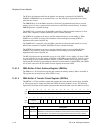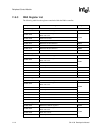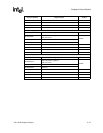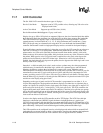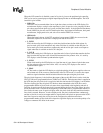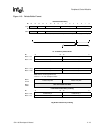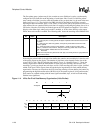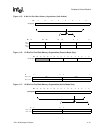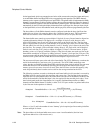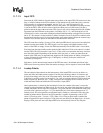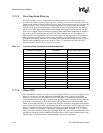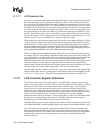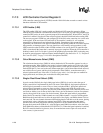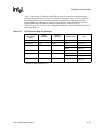
11-20 SA-1100
Developer’s Manual
Peripheral Control Module
The first palette entry (palette entry 0) also contains an extra field that is used to synchronously
configure the LCD controller at the beginning of each frame. Bits 12 and 13 of the first palette
entry contain a field that is used to select the number of bits per pixel that is to be used in the next
frame (see Figure 11-3). The pixel bit size (PBS) bit-field is decoded by the LCD to correctly
unpack pixel data into nibbles, bytes, 12-bit values, or half-words, and by the palette to tell it how
many address bits are contained in the pixel data it is supplied, configuring the palette size to 16 or
256 entries. Note that 12/16-bit pixel mode bypasses the LCD palette and supplies 12-bit values
directly to the dither logic when passive mode is enabled, or 16-bit values directly to the output
FIFOs when active mode is enabled. The following table shows the encoding of the PBS bit field.
Following the palette buffer is the pixel data buffer that contains one encoded pixel value for each
of the pixels present on the display. The number of pixel data values depends on the size of the
screen (1024 x 768 = 786,432 encoded pixel values). Figure 11-4 through Figure 11-7 show the
memory organization within the frame buffer for each size pixel encoding. Note that for 4-bit
encodings, 2 pixels are placed into each byte, and for 12-bit encodings the value is right- justified
within a half-word. These figures show the encoded pixel organization for little endian memory
organization. The user can select how the LCD views the ordering of frame buffer pixel entries by
programming the big/little endian select (BLE) bit in LCD control register 0. In big endian mode,
pixel entries are ordered starting with the most significant nibble, byte, or half-word and ending
with the least significant.
Figure 11-4. 4 Bits Per Pixel Data Memory Organization (Little Endian)
Bit Name Description
13..12 PBS Pixel bit size.
0x – 4 bits per pixel, 16-entry palette, 32 bytes of palette buffer transferred each frame
to palette.
01 – 8 bits per pixel, 256-entry palette, 512 bytes of palette buffer transferred each
frame to palette.
10 – 12 bits per pixel in passive mode (PAS=0), 16 bits per pixel in active mode
(PAS=1). Palette unused, however, 32 bytes of “dummy” palette data is transferred
each frame to palette. Palette data must be zero-filled.
11 – Reserved.
Note: Two 4-bit pixels are packed into each byte, and 12-bit pixels are right justified on
half-word boundaries.
Bit 3210
4 bits/pixel Encoded Pixel Data<3:0>
Bit312827242320191615121187430
Base +
0x20
Pixel 7 Pixel 6 Pixel 5 Pixel 4 Pixel 3 Pixel 2 Pixel 1 Pixel 0
Base +
0x24
Pixel 15 Pixel 14 Pixel 13 Pixel 12 Pixel 11 Pixel 10 Pixel 9 Pixel 8
..



